Have you ever left a rubber band lying around, only for your curious kitty to munch on it? If so, don’t fret – you’re not the only pet parent to experience this.
While cats love to play with anything they can get their paws on, even harmless things like rubber bands can lead to serious health issues in felines.
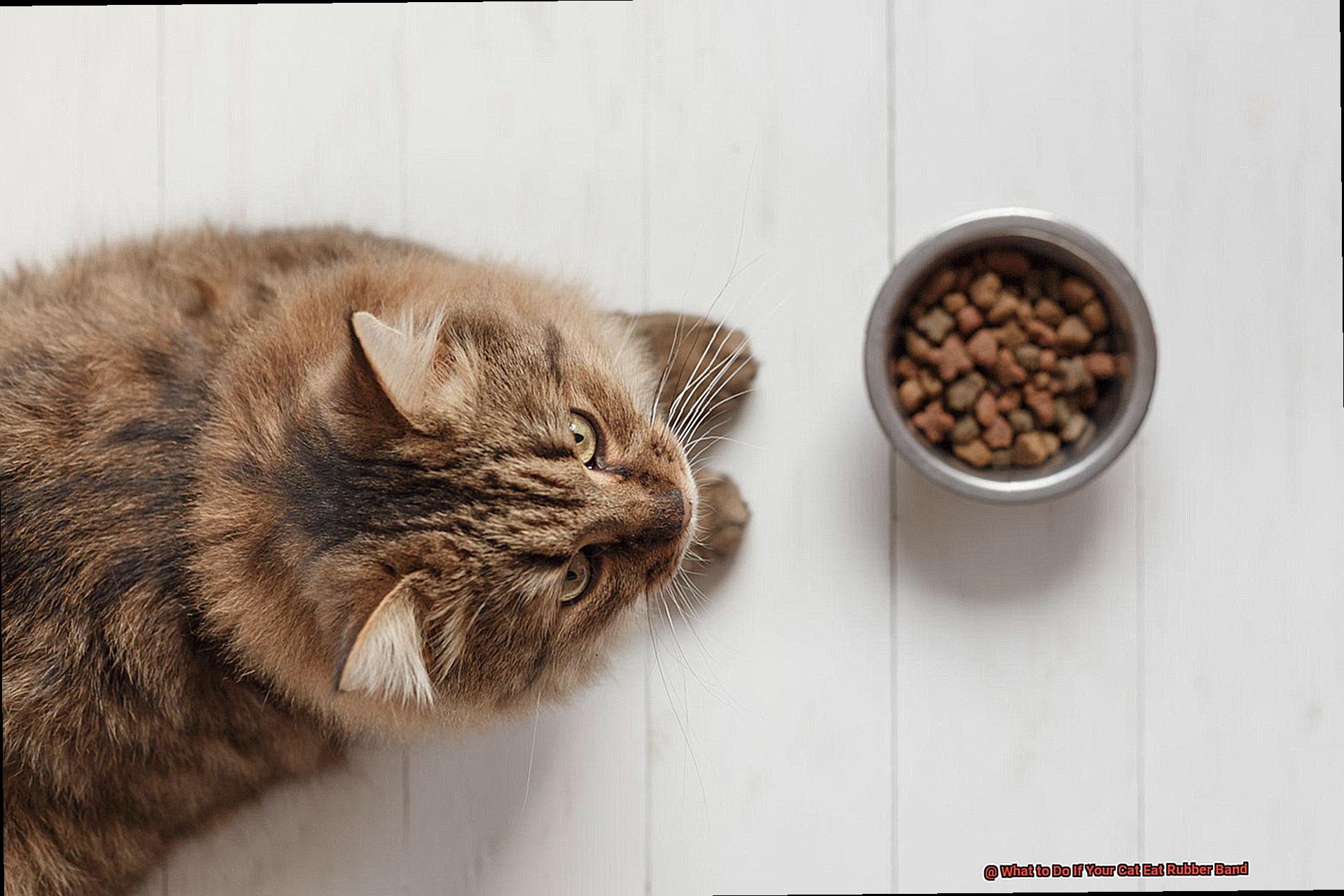
Eating a rubber band may seem like a trivial event, but it can cause a lot of trouble for your furry friend.
If left unaddressed, the elastic material can entangle in their intestines and cause dangerous blockages, leading to pain, vomiting, and even death.
So, what steps should you take if your cat eats a rubber band? Firstly, don’t panic – taking matters into your own hands can do more harm than good.
Instead, it’s best to seek medical help as soon as possible.
In this blog post, we’ll explore the risks associated with cats consuming rubber bands, and guide you through the most effective ways to support your pet in this scenario.
We’ll take you through the entire process – from reaching out to your vet, conducting a physical exam, monitoring your cat’s behavior, and administering medication.
Together, let’s learn how to safely handle this alarming situation for your furry buddy’s benefit.
Can cats digest rubber?
The answer is a resounding no.
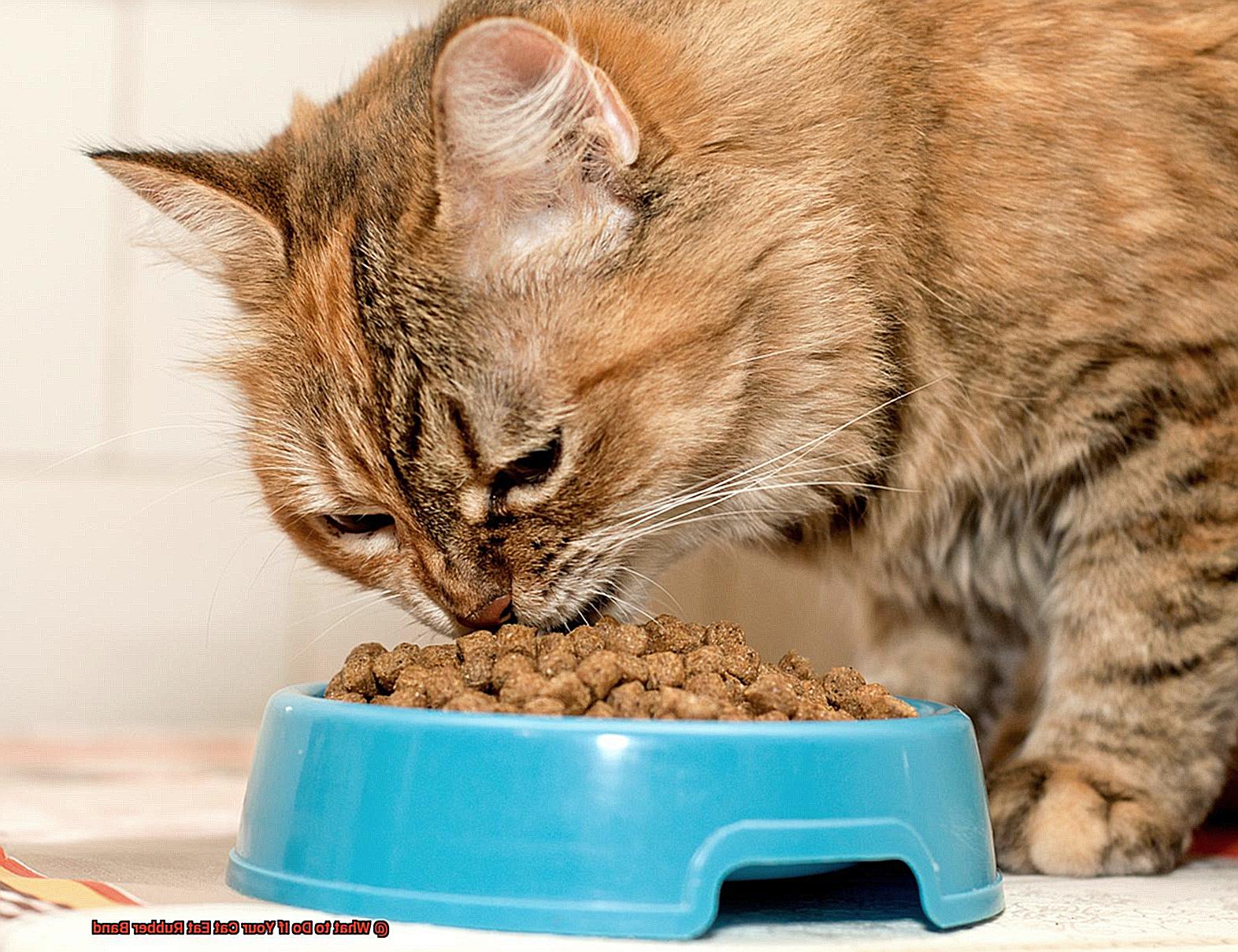
While a cat’s digestive system is uniquely adapted to break down certain types of food, rubber is not one of them.
Simply put, a cat’s digestive system is not capable of breaking down rubber due to its chemical composition.
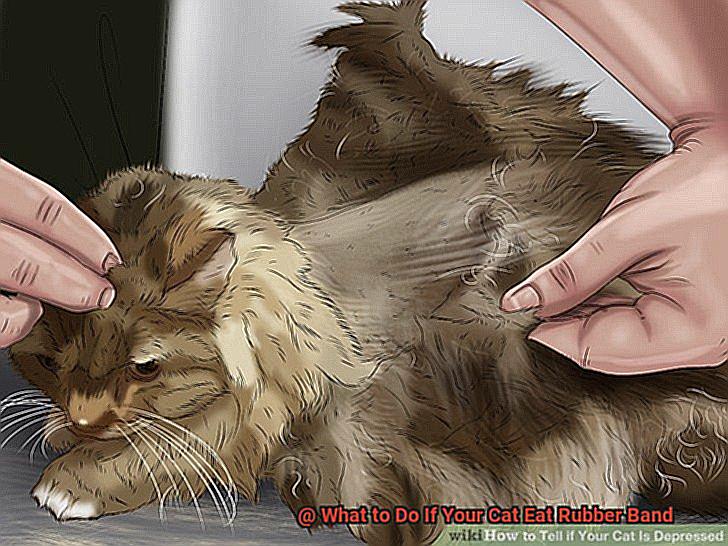
If a cat ingests a small rubber band, it may pass through their digestive tract without complications.
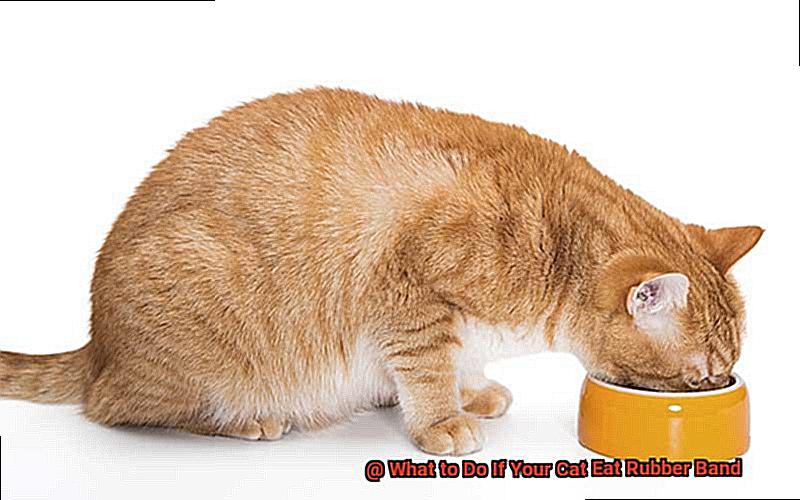
However, larger pieces or ones that become lodged can cause dangerous blockages and potentially life-threatening complications.
But what about the stomach acid in cats? Can it help dissolve rubber? While it is true that stomach acid can break down some types of rubber, it cannot do so at a fast enough rate to quickly and safely expel the material from a cat’s digestive system.
So, what steps should cat parents take if they suspect their furry friend has ingested a rubber band? First and foremost, keep an eye on your cat’s behavior for any signs of discomfort, such as vomiting or constipation.
Have you noticed that your cat has eaten a rubber band? Then it is essential to seek veterinary attention immediately.
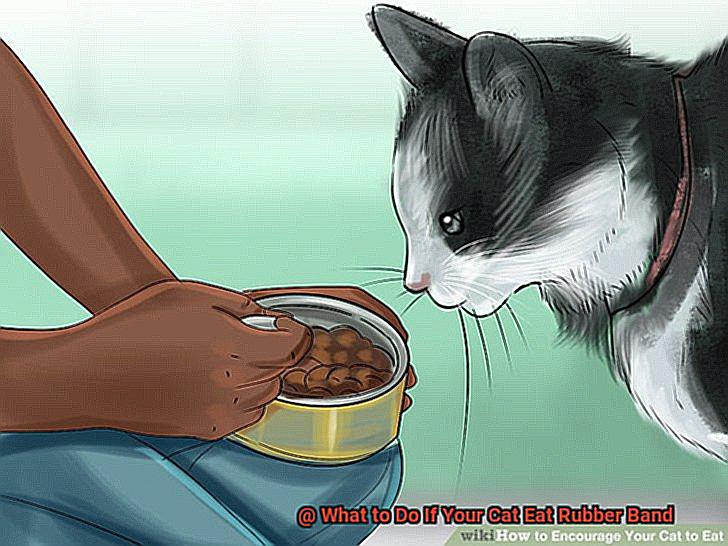
If caught early enough, a veterinarian may be able to induce vomiting to help expel the rubber band.
But be warned, never try to induce vomiting at home without the guidance of a veterinarian as it can be dangerous if done incorrectly.
In severe cases, your cat may require surgery to remove the obstruction.
Can a cat die from eating a rubber band?
From tangled up strings to crumpled paper, nothing is off-limits for them.
However, there are some unexpected items that can be dangerous to our furry friends, such as rubber bands, which can lead to serious health problems or even death.
Here are the potential risks and dangers of rubber band ingestion in cats.
First off, if a cat ingests a rubber band, it can cause an obstruction in the digestive tract, which can lead to a variety of health problems, ranging from mild to life-threatening.
The obstruction can prevent food from passing through, causing an accumulation of undigested food and bacteria in the digestive tract.
This can lead to infections, inflammation, and other gastrointestinal issues, which can ultimately result in the cat’s death if left untreated.
There is also a risk of rupture of the intestinal wall if the cat ingests a rubber band.
This can cause the contents of the intestine to leak into the abdominal cavity, leading to severe inflammation and infection known as peritonitis.
This condition requires immediate medical attention and treatment, as it can quickly become fatal.
While the chances of a cat dying from ingesting a rubber band may be low, it is still a possibility.
Therefore, it is crucial to be proactive in preventing the ingestion of rubber bands.
Store them safely and out of reach of your cat.
Additionally, be vigilant in watching over your cat’s behavior and environment, especially when they are playing with small objects.
If you suspect your cat has ingested a rubber band, keep an eye out for signs like vomiting, diarrhea, abdominal pain, or a loss of appetite.
What to do if your cat has eaten a rubber band?
Rubber bands might seem like harmless household items, but for cats, they pose a potential threat to their health.
Ingesting a rubber band may cause a blockage in the digestive tract or even choke your cat.
It’s crucial to take immediate action if you suspect your cat has eaten a rubber band.
Here’s a step-by-step guide on how to respond to a rubber band ingestion incident.
Watch for Symptoms
Keep a close eye on your cat’s behavior and be aware of early symptoms.
Symptoms of rubber band ingestion may include vomiting, diarrhea, lethargy, loss of appetite, and difficulty breathing.
Check your Cat’s Mouth
Inspect your cat’s mouth to see if you can find any remnants of the rubber band.

Be cautious to avoid hurting your cat while doing so.
Contact your Vet
If your cat is showing any symptoms of rubber band ingestion, it’s essential to take quick action by contacting your vet.
They will advise you on the best course of action, including inducing vomiting or taking your cat to the vet or an animal hospital for further evaluation and treatment.
Monitor your Cat
Once initial steps have been taken, it’s crucial to keep monitoring your cat’s behavior.
If any symptoms worsen or new ones appear, contact your vet immediately.
Follow your Vet’s Instructions
Your vet will provide you with instructions on how to care for your cat, including feeding, medication, and any follow-up appointments.
Ensure you follow their advice for the best possible outcome.

Prevention is always better than cure when it comes to your cat’s health.
To avoid rubber band ingestion, follow these tips:
Store Rubber Bands
Keep rubber bands and other small items out of reach of your cat.
Store them in secure cabinets or drawers your cat cannot open.
Safer Toys
Provide your cat with safe and alternative toys, such as catnip-infused toys, balls, or feather wands that can encourage physical activity.
Playtime
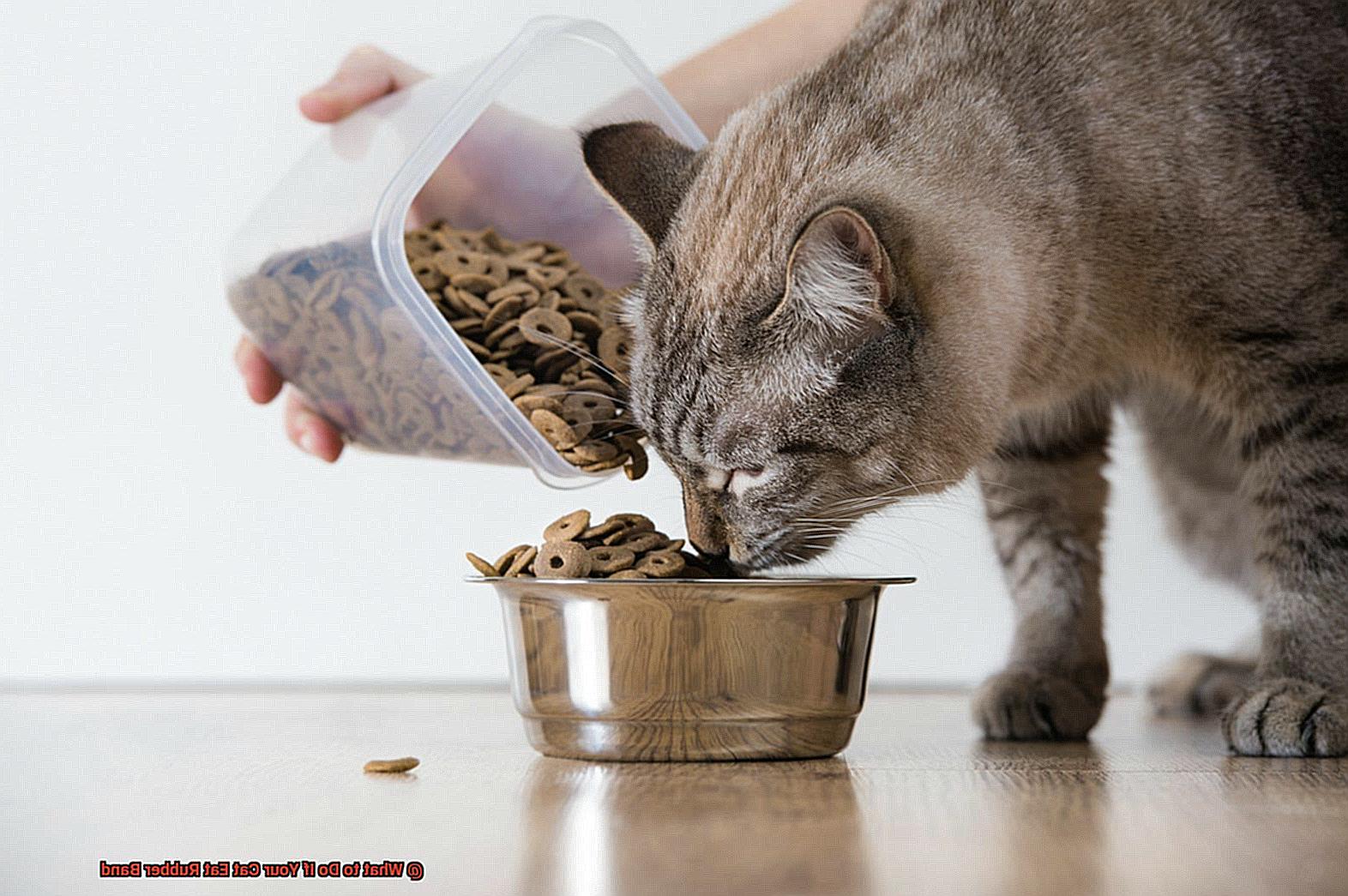
During playtime, monitor your cat closely and avoid leaving small items unattended.
Ensure Your Floor
Keep your floor free of small toys and any other hazardous household items.
Regular Vet Visits
Regular vet visits are crucial in detecting any potential health problems early and keeping your cat healthy.
So, if you suspect your cat has eaten a rubber band, take immediate action by contacting your vet.
How to monitor your cat’s condition
After a cat ingests a foreign object, such as a rubber band, it’s important to monitor their behavior and physical symptoms to ensure their wellbeing.
In this blog post, we’ll tackle five essential tips on how to monitor your cat’s condition and take appropriate action.
Watch out for Physical Symptoms
Vomiting, abnormal stool, and signs of discomfort such as whining or meowing excessively can be signs of a blockage in your cat’s digestive system.
Other signs to watch out for include lethargy, loss of appetite, or changes in litter box habits.
Remember, cats may show various signs of discomfort, so pay attention to any changes in their behavior and overall health.
Track Your Cat’s Stool
Check your cat’s litter box for any foreign objects in your cat’s stool, such as rubber or plastic, and note the color and consistency of their stool.
Any noticeable changes could indicate gastrointestinal distress, and it’s important to take immediate action by contacting your veterinarian.
Monitor Behavioral Signs
Excessive grooming, restlessness or vocalization could be a sign that your cat is in distress.
Pay close attention to any changes in your cat’s energy levels, mood, and temperament.
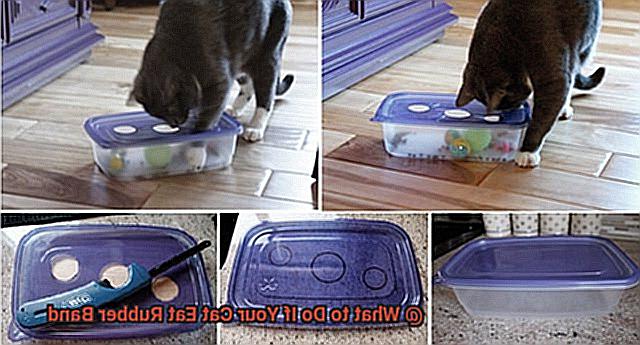
If your cat seems lethargic or uninterested in their usual daily activities, contact your veterinarian immediately.
Contact your veterinarian
If your cat shows any signs of distress after ingesting a foreign object, it’s essential to seek professional help immediately.
Your veterinarian will guide you on what steps to take, ranging from inducing vomiting to performing an X-ray to identify any foreign objects.
Practice Preventive Measures
Prevention is always better than cure.
It’s essential to keep any rubber bands or small objects out of your cat’s reach.
Consider using storage containers with tight-fitting lids and keeping small objects out of your cat’s reach.

Ensure that the environment your cat lives in is free of hazards that could cause injury.
In conclusion, monitoring your cat’s behavior and physical symptoms after ingesting a foreign object such as a rubber band is vital.
It’s essential to seek immediate veterinary attention if you notice any signs of distress or changes in your cat’s behavior or physical symptoms.
How long does it take to digest a rubber band?
As you watch your cat every day, you might have noticed that they are fond of chewing on various items.
Rubber bands are one such item, and you may be wondering how long it will take for your feline friend to digest the rubber band if they swallow it.
Let’s delve into the process of digestion in cats and the factors that affect how long it takes for a rubber band to pass through their digestive system.
Cats are obligate carnivores, which means that their digestive system is designed to break down proteins and fats from animal sources required for them to meet their nutritional needs.
However, they might still ingest inedible things like rubber bands.
When a cat swallows a rubber band, the body will attempt to digest it, but the synthetic rubber can resist chemical and enzymatic breakdown in their stomachs and intestines.
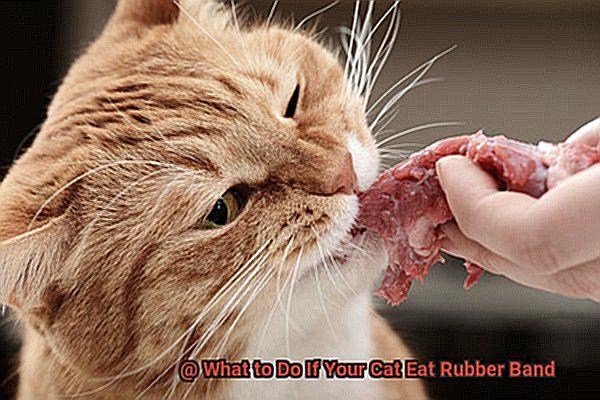
Consequently, it can take a considerable amount of time for the cat’s body to get rid of the rubber band.
Depending on several factors, it can take up to several weeks or even longer for the rubber band to pass through the digestive system.
The duration that the rubber band takes to pass relies on several elements, including the size of the rubber band, the cat’s age, health status, diet, exercise, and location of the rubber band.

In general, larger-sized rubber bands will take longer to pass through the digestive system.
Younger, healthy cats tend to digest food more quickly and eliminate objects faster than older, unhealthy cats.
A balanced diet and regular exercise can also contribute to faster digestion processes.
If you notice any symptoms of blockage in your cat, such as vomiting, diarrhea, abdominal pain, loss of appetite, and lethargy, it’s crucial to seek veterinary care immediately.
If the rubber band is causing an obstruction, the duration it takes for it to pass through the system will be longer.
In severe cases, your cat might even require surgery to remove the blockage.
Therefore, it’s important to keep small objects out of your cat’s reach and create a safe environment for your feline friend.
As a responsible pet owner, it’s essential to ensure that your cat’s home is free of any hazards that could result in injury or illness.
Remember, prevention is always better than cure.
How long does it take for a cat to pass an object?
Cats have fast metabolisms, and their digestive systems are designed to break down food quickly.
However, that does not mean foreign objects pass quickly.
The timeline can vary depending on multiple factors, including the age and health of your cat, the size and shape of the object, and if there are any obstructions in their organs.

The size and shape of the object are crucial factors in passing through a cat’s system.
For instance, smaller objects, like rubber bands, can pass in a day or two.
However, larger objects can take up to months.
If the object gets stuck in the digestive system, it can lead to obstructions, harmful bacterial infections, or cause your cat to experience discomfort.
It’s essential to keep the age and health of your cat in mind when dealing with such situations.
If your cat is a senior or has pre-existing medical conditions, they have a slower digestive rate, leading to a longer retention time in the digestive tract.
In such cases, closely monitoring your cat’s behavior, eating habits, and bowel movements, is vital.
The best way to avoid such situations from arising in the first place is prevention.
Keep small objects out of reach of our curious pets, and store them in safe and secure places.
Always keep an eye on your furry friend to prevent them from getting into trouble.
Can stomach acid dissolve rubber?
The answer is no. Stomach acid is not strong enough to break down rubber.
Thus if a rubber band remains inside the digestive tract, it could lead to severe problems.
It’s essential to act quickly if your cat swallows a rubber band to prevent any life-threatening complications.
The first step is to observe your cat’s behavior and symptoms.
If your furry pal displays signs of distress or starts throwing up, it’s imperative to take them to a vet immediately.
When your cat is in good condition, a high-fiber diet and access to plenty of water can aid in the movement of the rubber band through their system.
It’s crucial to seek medical guidance and supervision from a vet before attempting this approach.
In worse case scenarios, surgery may be the only solution to remove the rubber band.
As a responsible owner, monitoring your cat’s activities, and keeping small objects like rubber bands out of their reach are essential.
Cats have an inquisitive nature and love experimenting with and chewing on small objects.
Therefore, its crucial to ensure your furry friend is safe in your household.
When to seek veterinary attention
Knowing when to seek veterinary attention for rubber band ingestion can prevent complications and even save your cat’s life.
Keep an eye out for symptoms like vomiting, diarrhea, lethargy, loss of appetite, and discomfort.
If your cat shows any signs of discomfort, it’s vital to call your veterinarian as soon as possible.
It’s always better to be safe than sorry, especially when it comes to your beloved feline.
When you arrive at the veterinary office, the vet will likely ask about the symptoms and when you last saw your cat playing with the rubber band.
X-rays or ultrasounds may be needed to identify the exact location of the rubber band and assess any blockages.
Based on the extent of the injury, your veterinarian may suggest inducing vomiting, administering medication, or performing surgery to remove the rubber band.
Afterward, your cat may require close observation to prevent complications or further intervention.
Remember, rubber bands cannot be dissolved by stomach acid and can cause severe health issues if ingested.
Keeping small objects like rubber bands out of reach of curious cats can prevent accidental ingestion and keep your pet safe and healthy.
Conclusion
Our feline friends are known for their curious nature and sometimes, that leads them to munch on things they shouldn’t.
And when it comes to rubber bands, it’s important to remember that they can cause serious health issues for cats.
These can range from blockages in the intestines to nausea, vomiting, and even death.
If you find that your cat has ingested a rubber band, the first thing to do is to remain calm and contact your veterinarian immediately.
It’s important to resist the urge to induce vomiting or take matters into your own hands, and instead, rely on the guidance of a veterinary professional.
Be sure to keep a close eye on your cat’s behavior and physical signs and follow any instructions the vet gives you.
Remember that in situations like this, swift action can make all the difference in your cat’s health and wellbeing.
And last but not least, don’t forget to have your cat’s vet records and passport up-to-date.







